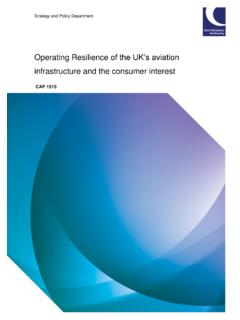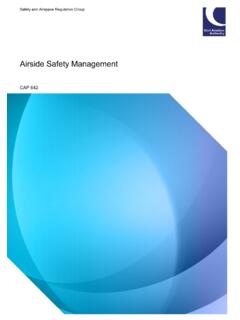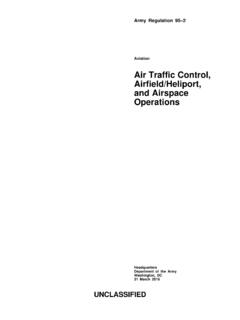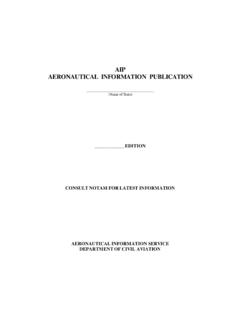Transcription of Safety and Airspace Regulation Group - CAA
1 Safety and Airspace Regulation Group Safeguarding of Aerodromes CAP 738 Published by the Civil Aviation Authority, 2020 Civil Aviation Authority Aviation House Beehive Ring Road Crawley West Sussex RH6 0YR You can copy and use this text but please ensure you always use the most up to date version and use it in context so as not to be misleading, and credit the CAA. Published February 2003 Second edition December 2006 Third edition October 2020 Enquiries regarding the content of this publication should be addressed to: Safety and Airspace Regulation Group Civil Aviation Authority Aviation House Beehive Ring Road Crawley West Sussex RH6 0YR The latest version of this document is available in electronic format at: CAP 738 Contents October 2020 Page 3 Contents Contents 3 Foreword 6 Revision history 8 Executive summary 9 Introduction 9 Safeguarding Scope 11 Chapter 1 Basics of Safeguarding 13 What is Aerodrome Safeguarding 13 How to set up consultation 13 Details needed to assess an application 14 Instrument Flight Procedures 16 Chapter 2 Official and non-official Safeguarding 18 Official and non-official Safeguarding explained 18 Officially Safeguarded Aerodromes 18 Non-officially Safeguarded Aerodromes 19 Chapter 3 The Safeguarding Process 21 Safeguarding Assessment 22 Insufficient Information 22 Requesting planning Conditions 23 Additional items to consider in the assessment 24 Cranes and other vertical structures 24 Roads and railways 26 Lighting 27 Landscaping 27 General Permitted Development Order (GPDO)
2 27 Other considerations 28 CAP 738 Contents October 2020 Page 4 Chapter 4 Producing a safeguarding map 29 Aerodrome Characteristics 29 Runway Strip and Obstacle Limitation Surfaces 29 Technical Sites 30 Coloured Tiles for Consultation 30 Chapter 5 Obstacle Limitation Surfaces explained 32 Transitional Surface 32 Inner Horizontal Surface 34 Conical Surface 35 Outer Horizontal Surface 36 Approach Surface 37 Take Off Climb Surface 39 Obstacle Free Zone (OFZ) Explained 44 Aerodrome survey and obstacle collection areas (eTOD) Explained 46 Chapter 6 Safeguarding Assessment 47 Calculating the Obstacle Limitation Surface (OLS) - v - Obstacle 47 The Transitional Surface 47 The Conical Surface 50 Chapter 7 London Tall Buildings Policy 52 Chapter 8 heliports 56 Introduction 56 Safeguarding the Heliport 56 Chapter 9 Hospital helicopter Landing Sites (HHLS) 58 Introduction 58 Safeguarding the site 58 Appendix A Wind Turbine Safeguarding Maps 60 Appendix B Cranes and Associated Lighting 62 Introduction 62 CAP 738 Contents October 2020 Page 5 Crane Activity in the Vicinity of an Aerodrome 62 Aviation Warning Lighting 63 Notification 63 Appendix C Solar Photovoltaic Cells 64 Policy 64 Other Considerations 64 Appendix D Completing a Safeguarding Assessment (Structures)
3 65 Appendix E Safeguarding Assessment Slip 66 Appendix F Shielding 67 Appendix G Sample Aviation Safeguarding Procedure 69 Appendix H Safeguarding Checklist 74 CAP 738 Foreword October 2020 Page 6 Foreword Civil Aviation Authority (CAA) Civil Aviation Publications (CAPs) are based upon UK legislation and non-legislative regulatory material, such as ICAO Standards and Recommended Practices. They are published in order to provide UK industry with: a) guidance and clarification on the means of achieving compliance with global, UK and European regulatory requirements, and where applicable: b) details of United Kingdom (UK) Alternative Means of Compliance , and c) details of any additional national requirements, including CAA administrative procedures. Details of appropriate supporting administrative procedures are also included where necessary.
4 In publishing CAPs, the CAA satisfies the obligations placed upon it by the Transport Act 20001, Chapter 1 Article 2 CAA s general duty , which in paragraph 2(a) requires the CAA to exercise its functions under the Act in the manner it thinks best calculated, to further the interests of operators and owners of aircraft, owners and managers of aerodromes, persons travelling in aircraft and persons with rights in property carried in them. The only interests to be considered under subsection (2)(a) are interests regarding the range, availability, continuity, cost and quality of air traffic services. Publication of CAPs additionally satisfies the requirements set out by the Civil Aviation Authority (Chicago Convention) Directions 20072 to ensure that it acts consistently with the obligations placed on the UK under the Chicago Convention. The CAA is obliged to consider whether it is necessary to amend United Kingdom aviation legislation to ensure appropriate implementation of an ICAO provision.
5 Where (a) the CAA considers it inappropriate to transpose an ICAO provision into domestic legislation and (b) the CAA has discretionary power to enforce the requirements of such a provision through a certificate, licence, or other means of approval, the Civil Aviation Authority (Chicago Convention) Directions 2007 obliges the CAA to develop and publish such requirements as are necessary to implement the ICAO provision and shall ensure that it is able to verify adherence to those requirements. CAPs are subject to periodic revision to take account of changes to source regulatory material, feedback from industry, and recognised best practice. CAP 738 provides 1 or 2 (ChicagoConvention)Directions2007(asamen ded).pdf CAP 738 Foreword October 2020 Page 7 applicable guidance and clarification relating to Aerodrome Safeguarding and is to be read in conjunction with CAP 168, CAP 232, CAP 1732, CAP 1096 and CAP 1054 the regulatory material referenced below.
6 Non-inclusion of source regulatory material within this CAP does not preclude the end user from either the need to be aware of, or the need to comply with, the requirements contained within the source regulatory materials unless otherwise exempted from those requirements. It is the policy of the UK government that, unless a Difference (from an ICAO requirement) or Alternative Means of Compliance (AltMoC) (related to an EASA Acceptable Means of Compliance (AMC)) has been established, compliance with relevant international ( ICAO and applicable equivalents such as International Telecommunications Union) and European regulatory material is required to the extent mandated in law. Additionally, compliance with national requirements that are not addressed by international or EU regulations is also required. The words must , shall and will indicate that compliance with applicable regulatory requirements is necessary.
7 In the case of AMC, the word should indicate that compliance is required, unless complying with an approved AltMoC. Regulatory References: CAP 738 is published to assist Aerodrome Operator s understanding of, and compliance with the requirements laid down in: ICAO: Annex 14 Volume I, Aerodrome Design and Operations, Annex 14 Volume II, heliports EU: Regulation (EU) 2018/1139, Regulation (EC) No 1108/2009, COMMISSION Regulation (EU) No 139/2014 UK: CAP 168 Licensing of Aerodromes CAP 738 Revision history October 2020 Page 8 Revision history 1st Edition February 2003 CAP 738 offers guidance to those responsible for the safe operation of an aerodromes or technical site, to help them assess what impact a proposed development or construction might have on that operation. The assessment is known as Safeguarding. 2nd Edition December 2006 This edition incorporates the inclusion of the London Tall Buildings Policy.
8 In addition, the opportunity has been taken to incorporate a few minor changes to the text. 3rd Edition October 2020 This edition incorporates substantial changes to the content to include additional guidance material for Heliport safeguarding and to generally improve the clarity of the information with respect to official and non-official aerodrome safeguarding. CAP 738 Executive summary October 2020 Page 9 Executive summary Introduction 1. This publication is intended to provide advice and guidance to all those involved in the process of aerodrome safeguarding . Primarily these are certificated and licensed aerodromes, heliports and hospital helicopter landing sites (HHLS) but non-licensed aerodromes, heliports and HHLS3 may find the information of assistance. Additionally, the publication provides guidance on the planning process for those aerodromes that are officially safeguarded in accordance with DfT Circular 01/2003 and those non-officially safeguarded aerodromes that may wish to establish a similar process with their Local planning Authority.
9 The content will clarify who the guidance is aimed at. 2. The safeguarding system described in this CAP satisfies International Civil Aviation Organisation (ICAO), European Union (EU) and National Regulations, which state: a) ICAO Annex 14, Volume I i. Requires that Contracting States define the Airspace around aerodromes to be maintained free from obstacles so as to permit the intended aeroplane operations at the aerodromes to be conducted safely and to prevent the aerodromes from becoming unusable by the growth of obstacles around the aerodromes. This is achieved by establishing a series of obstacle limitation surfaces that define the limits to which objects may project into the Airspace . ii. Objects which penetrate the obstacle limitation surfaces may in certain circumstances cause an increase in the obstacle clearance altitude/height for an instrument approach procedure or any associated visual circling procedure or have other operational impact on flight procedure design.
10 Criteria for flight procedure design are contained in the Procedures for Air Navigation Services Aircraft Operations (PANS-OPS, Doc 8168). 3 There is an action from the onshore helicopter review (CAP 1864) which states the CAA will establish a work Group with key stakeholders and operators to review the provision of Hospital helicopter Landing Site information with the aim of adopting a unified controlled source similar to that used for offshore helidecks. CAP 738 Executive summary October 2020 Page 10 iii. Action shall be taken to decrease the risk to aircraft operations by adopting measures to minimize the likelihood of collisions between wildlife and aircraft. b) ICAO Annex 14, Volume II i. Requires that the Contracting State define the Airspace around heliports so as to permit intended helicopter operations to be conducted safely and to prevent, where appropriate, heliports from becoming unusable by the growth of obstacles around them.


















